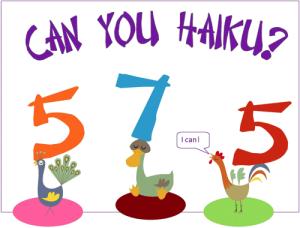| Humor Fiction posted July 9, 2017 |
      |
The origins of haiku.
Haiku - The movie
by Thomas Bowling

Haiku, or as it's sometimes called Japan's Revenge, is sweeping the nation. For this reason, I'm releasing soon, in a theater near you, my new film. Haiku – The Movie. It promises to be an action-packed film, written entirely in haiku. This was difficult since haiku doesn't permit dialogue, but with clever editing, I was able to work around this seamlessly.
Haiku was invented by Mutsubishiharimokosushigeshiasasuki. He originally wanted to name the new style after himself, but due to a copyright suit filed by a soy sauce company with the same name, he had to settle for haiku. He discovered the new form, when after a long night, with way too much sake, he awoke to find that his dog, Ginsu, had eaten his sonnet and crapped out several pieces of haiku. Much haiku are still written this way. In fact, the word haiku translates to dog crap.
Haiku has very loose rules. The poem can be any length, and have any number of syllables, as long as it is three lines long, and contains seventeen syllables, or whatever fits on your paper. That is not to say that haiku is set in stone. Case in point is the fact that in 1964, the rules were modified to allow seventeen syllables. Before 1964, haiku was limited to sixteen syllables. The addition of a seventeenth syllable opened the way for a whole new interpretation of the style. Old poems were reexamined and found to contain hidden meanings that could now be expressed with the added syllable. Still in effect is the primary rule of all haiku. It must not be understood by anyone, at any time, or any place. Furthermore, when translated it must be in an unreadable form. Soon, new haiku flooded the market. This new freedom of expression greatly expanded the depth and allowed writers to experiment in realms that before, were only dreamed of. Now, porn could be written in haiku. A hardcore group quickly expressed their concern. Calling themselves the Sweet Sixteeners they lobbied for a return to the traditional sixteen syllables. In the end, the Seventeeners won out, and it remains the accepted form.
Recently, a new form of Haiku appeared on the stage that does away with all rules. It's called Anything Goes When the Whistle Blows Haiku. This is my favorite form of poetry. I have written an anthology titled Haiku/Sonnet Mashups. Many of the poems are eighteen stanzas long. It’s amazing how much can be expressed using only eighteen stanzas. That is not to say it is without limitations. It’s difficult to write eighteen stanzas without talking about me. The rules of haiku strictly forbid this. Rule 429 states that no haiku can be about Tom. I can write about my cat, but not me. How is this fair?
I am working on Kama Sutra Haiku. This is not a tabletop book, but it's very informative with full-color photos. I expect this to be a best seller. Amazon is currently accepting advance orders.
As you see, the rules of haiku are very simple. This is why newbies are flocking to it like flies on . . . haiku.
 Recognized |

© Copyright 2025. Thomas Bowling All rights reserved. Registered copyright with FanStory.

Thomas Bowling has granted FanStory.com, its affiliates and its syndicates non-exclusive rights to display this work.


